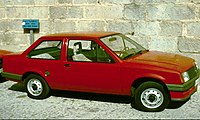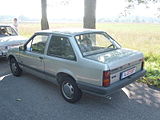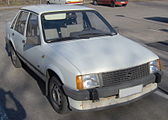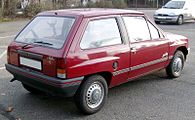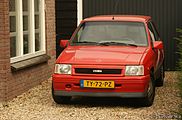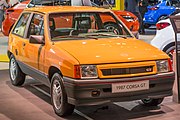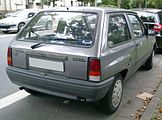Opel Corsa A.
| Opel | |
|---|---|
|
Opel Corsa three-door (1982–1987)
|
|
| Corsa A | |
| Production period: | 1982-1993 |
| Class : | Small car |
| Body versions : | Station wagon , sedan |
| Engines: |
Otto engines : 1.0–1.6 liters (33–74 kW) Diesel engines : 1.5 liters (37–49 kW) |
| Length: | 3622-3955 mm |
| Width: | 1532-1540 mm |
| Height: | 1360-1365 mm |
| Wheelbase : | 2343 mm |
| Empty weight : | 735-865 kg |
| successor | Opel Corsa B. |
The Opel Corsa A is a small car of the Corsa series built by General Motors from autumn 1982 to early 1993 .
Model history
General
The Corsa A was presented in October 1982. It was produced in the General Motors plant in Figueruelas , Spain .
The Corsa A was Opel's first model in the small car class - relatively late, after the VW Polo had been on the market in March 1975 and the Ford Fiesta in May 1976. He continued the conversion of the Opel model range from rear-wheel to front-wheel drive, which began in the summer of 1979 with the Kadett D , which was the first compact Opel front-wheel drive. The know-how and various parts have been "recycled" for the Corsa A.
In Germany, the Corsa was available from March 1983 as a three-door hatchback ("CC") and as a two-door notchback (called "TR") with a 1.0S OHV engine with 45 hp , 1.2S OHC engine with 55 hp and 1 , 3S OHC engine with 70 hp available, the basic design of the OHV engine being based on the 1.0 liter engine of the Kadett A presented in mid-1962 .
From April 1985, both body variants were also available with four or five doors. The equipment models were given new names, the previously unnamed standard model was given the name LS, the Corsa Luxus gave way to the Corsa GL and the Corsa Berlina was replaced by the Corsa GLS. The Corsa SR was only slightly changed, it was now called the Corsa GT and was still only available with three doors. The designation TR for the notchback models was dropped. There were new colors and fabrics in the interior. The previous plastic side protection strips were replaced by those made of soft PVC, such as in the Kadett E.
From September 1985 there was a 1.3i OHC engine (60 hp, with a regulated catalytic converter ). In the notchback model, the gray film strip on the trunk lid was omitted.
From March 1986 the 1.3N OHC engine with 60 hp was also available in the Corsa A. There was also a 1.2N OHV engine with 45 hp. The engine program now comprised six versions.
Facelift
During the first facelift in August 1987, the radiator grille was modified, notchback and hatchback models had the same grille since then, the GT and later the GSi had their own grills. A handle bar with a push-button lock was introduced on the tailgate of the hatchback models so that the tailgate could be opened without a key (if it was not locked). The notchback versions kept the previous lock without a handle bar. The rear view has been upgraded here with a black, fluted plastic cover between the rear lights. Previously gray outer plastic parts have been changed to blue-gray. In the interior (partly changed colors and fabrics), changed instruments in transmitted light technology have now been used. The Corsa LS was replaced by the Corsa Swing, a new, significantly upgraded Corsa GL replaced the Corsa GLS. A new, simply equipped entry-level version called the Corsa City was added later, only available with three doors. Isuzu diesel engines with 1.5 liters and 50 hp (Opel engine code 4EC1) were new in the Corsa, and the later turbo version with 67 hp (Opel engine code T4EC1).
At the same time, the notchback models were stopped in Germany. For export, however, they rolled off the production line until the Corsa A ended in January 1993.
In May 1988, the sporty Corsa GSi with 1.6-liter OHC engine was launched as a three-door hatchback sedan. Initially it had an L3-Jetronic (E16SE, 74 kW / 100 PS), from 1989 optionally (on the German market as a replacement) a Motronic M1.5 (C16SEI, 72 kW / 98 PS) and a G-Kat. For export (e.g. Switzerland) it was also available with 75 HP (C16NZ).
In 1989 the 1.3-liter engines were replaced by 1.4-liter drilled out.
During the second facelift in September 1990, the radiator grille as well as the headlights and indicators, the bumpers, side protection strips and fenders in the area of the indicators were modified again. The new bumpers were now full-surface in front and rear in all versions, they are similar to those of the Astra F. The brand logo moved from the radiator grille to the bonnet. In the interior, the Corsa received a new dashboard with a completely different design. In addition, the equipment has become significantly more extensive. The notchback models, which had only been offered for export since 1987, were now only available with four doors.
The Corsa Joy was new and featured bright red, yellow, turquoise or blue fabrics and details in the interior (optionally with sports seats). The exterior paintwork was coordinated with the strong colors of the fabrics.
The most important technical innovation was the 1.2i OHC engine with a regulated catalytic converter and 33 kW / 45 PS. An eco version appeared later, which was equipped with a particularly long-geared five-speed gearbox and tires with optimized rolling resistance.
The Corsa GSi initially received the 98 hp version of the 1.6 liter. In May 1992 the Motronic was replaced by a Multec-M injection (C16SE, again 74 kW / 100 PS) as in the C14SE.
In March 1993, the Corsa A was prepared by the Corsa B replaced. About 3.1 million copies had been produced.
Tuning
The Corsa A became a popular tuning object. It was offered by companies such as Irmscher Automobilbau or Lexmaul as a convertible or Speedster , by Mattig as a wide body and by Michalak as a two-seater Spider.
Engines
Petrol engines
| model | Displacement | power | Engine code | Construction period | comment |
|---|---|---|---|---|---|
| 1.0 p | 993 cc | 33 kW (45 PS) | 10S (LP5) | 10 / 1982-01 / 1993 | OHV, carburetor |
| 1.2 N | 1196 cc | 33 kW (45 PS) | 12NC / E12GV (LY4) | 04 / 1985–01 / 1993 | OHV, carburetor |
| 1.2 i | 1196 cc | 33 kW (45 PS) | C12NZ (L71) | 09 / 1990-01 / 1993 | OHC, injection, CAT |
| 1.2 p | 1196 cc | 38 kW (52 hp) | 12NV (L84) | 02 / 1990-01 / 1993 | OHC, carburetor |
| 1.2 p | 1196 cc | 40 kW (55 PS) | 12ST / S12ST (L84) | 10 / 1982-01 / 1990 | OHC, carburetor |
| 1.3 N | 1297 cc | 44 kW (60 hp) | 13NB (LY1) | 03 / 1986-08 / 1989 | OHC, carburetor |
| 1.3 i | 1297 cc | 44 kW (60 hp) | C13N (L72) | 09 / 1985-08 / 1989 | OHC, injection, CAT |
| 1.3 p | 1297 cc | 51 kW (70 hp) | 13SB (LX9) | 10 / 1982-08 / 1989 | OHC, carburetor |
| 1.4 i | 1389 cc | 44 kW (60 hp) | C14NZ (2H6) | 09 / 1989–01 / 1993 | OHC, injection, CAT |
| 1.4 p | 1389 cc | 53 kW (72 PS) | 14NV (L89) | 09 / 1989–01 / 1993 | OHC, carburetor |
| 1.4 Si | 1389 cc | 60 kW (82 PS) | C14SE (L48) | 09 / 1991–01 / 1993 | OHC, injection, CAT |
| 1.6 i | 1598 cc | 53 kW (72 PS) | C16NZ (L73) | 03 / 1988-07 / 1991 | OHC, injection, KAT, initially 55 kW (75 PS), not available in DE |
| 1.6 GSi | 1598 cc | 72 kW (98 PS) | C16SEI | 10 / 1989-04 / 1992 | Injection, CAT |
| 1.6 GSi | 1598 cc | 74 kW (100 PS) | E16SE (L55) | 03 / 1988-04 / 1992 | injection |
| 1.6 GSi | 1598 cc | 74 kW (100 PS) | C16SE (L55) | 05/1992–01/1993 | Injection, CAT |
Diesel engines
| model | Displacement | power | Engine code | construction time | comment |
|---|---|---|---|---|---|
| 1.5 D | 1488 cc | 37 kW (50 PS) | 15D / 4EC1 (LW1) | 09.1987-01.1993 | - |
| 1.5 TD | 1488 cc | 49 kW (67 hp) | 15TD / T4EC1 (LM0) | 10.1987-01.1993 | Boost pressure 0.68 bar |
Web links
- opel-corsa-a.com, The story of the Corsa A , accessed on August 27, 2018.
Individual evidence
- ↑ a b c welt.de of September 15, 2014, Tradition: Five Generations of Opel Corsa , accessed on August 27, 2018.

